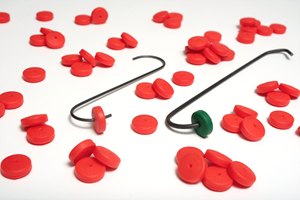Pink Coating on BSA Parts
I understand that iron and poor current can cause a pink coating on boric-sulfuric anodized (BSA) parts. What levels of iron are permissible before reaching the pink-colored coating? Are there any other things we could be missing?
Q. I understand that iron and poor current can cause a pink coating on boric-sulfuric anodized (BSA) parts. We currently process parts for Boeing, and the pink coating is a cause for rejection. We tested the BSA solution for copper and iron, and the copper level is at 11.64 ppm and the iron level is at 11 ppm. What levels of iron are permissible before reaching the pink-colored coating? Are there any other things we could be missing? E.M.
A. I am not familiar with the “pink coating” phenomenon using the boric-sulfuric process. I don’t think the problem is related to the dissolved copper and iron in the bath, however. The Boeing spec (BAC5632) has a limit for copper in the bath of 237 ppm; there is no mention of a limit for iron. In a “clear anodize” bath, any coloring of the product during the anodizing cycle is usually related to the alloy and/or temper of the parts being anodized. However, this is usually evident only with thicker coatings than the BSA process calls for. You don’t mention the coating thickness you are getting, nor do you mention the alloy being anodized. I am not familiar with which alloy series tends to produce pink coatings, but I don’t think this is your problem.
I also don’t know what you mean by “poor current.” If the parts are anodized in accordance with the Boeing spec, i.e., 15 volts for 20 to 25 min, the current density will normally be in the range of 3.5 to 4 asf, as long as there is some dissolved aluminum in the bath. A brand new bath with no aluminum (not recommended) will give a current density of 4 to 6 asf. If this is consistent with what you are getting, then the current is fine. There may be a separate problem with racking of the parts that might cause a lack of current flow to some parts and not others. This would result in the parts with poor electrical contact having slightly less coating than the parts with good electrical contact.
Sometimes the best way to correct the problem is to start over. This may correct the problem, but it may not tell you what was actually causing the problem. I would recommend the following course of action if you feel that the troubleshooting approach is not working:
- Dump the anodizing bath.
- Clean out the tank and give it a final rinse with DI water.
- Rinse out any piping associated with the system.
- Clean the cathodes as required.
- Take apart the bus bar/cables, and clean and renew all electrical bus connections from the tank to the rectifier.
- Re-make the bus connections using new Type 316 stainless steel fasteners and spring (Belleville) washers with each fastener.
- Use an electrical joint compound on the bus connections prior to making the connections. A product we use is called Alcoa Electrical Joint Compound (EJC) #2, but there are others such as Coppershield and more that can be used to good advantage. EJCs help keep the electrical joint clean and dry for months or years.
- Make up new chemistry. Use ACS-certified boric acid and sulfuric acid just to be sure that these are of high quality. (Some grades of sulfuric acid have more iron than others.)
- Add enough aluminum sulfate to bring the level up to 1 g/L. (Use 9.25 lbs of Al2(SO4)3 • 14H2O per 100 gal of bath to raise the aluminum content of the bath ~1 g/L.)
I would appreciate knowing if this causes the problem to go away.
Related Content
The Importance of Rack Maintenance
A look at how poor rack maintenance contributes to wasted time, wasted chemicals and wasted materials.
Read MoreCFS Unveils New Hook Locks Parts Racking Solution
New product from Custom Fabricating & Supplies (CFS) prevents part loss during coating processes.
Read MoreTroubleshooting 5 Common Racking Problems for Platers
Being aware of usual issues that might occur during the plating process will prepare platers by helping them know how to avoid them all together or how to fix them if they happen.
Read MoreChicago-Based Anodizer Doubles Capacity, Enhancing Technology
Chicago Anodizing Company recently completed a major renovation, increasing its capacity for hardcoat anodizing and Type II anodizing.
Read MoreRead Next
Delivering Increased Benefits to Greenhouse Films
Baystar's Borstar technology is helping customers deliver better, more reliable production methods to greenhouse agriculture.
Read MoreEducation Bringing Cleaning to Machining
Debuting new speakers and cleaning technology content during this half-day workshop co-located with IMTS 2024.
Read MoreA ‘Clean’ Agenda Offers Unique Presentations in Chicago
The 2024 Parts Cleaning Conference, co-located with the International Manufacturing Technology Show, includes presentations by several speakers who are new to the conference and topics that have not been covered in past editions of this event.
Read More













.jpg;maxWidth=300;quality=90)











